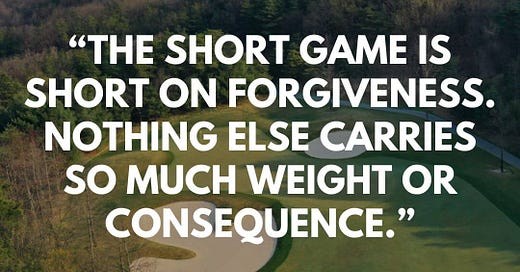Loss aversion putting.
Mike Malaska says, “The short game is short on forgiveness. No other part of the game carries so much weight or consequence.”
So today, let’s do something a little different. Let’s tell the story of a missed putt.
The New York Times reported on a study from the Wharton School. After analyzing 1.6 million putts on tour, they found that pros make par putts more often than birdie putts of the same distance.
That proves true for most of us as well.
The reason? Consequences.
We feel stronger about avoiding the penalty of a bogey than gaining the reward of a birdie. Psychologists call this “loss aversion.” It’s costing pros hundreds of thousands of dollars every year—and could be costing us better scores and lower handicaps.
Physical vs. psychological reality.
Think of a green at your home course. Visualize yourself standing over a 6-foot putt.
The physical reality of that putt—grass, slope, break, distance—doesn’t change. The psychological reality does.
Imagine you’re putting for birdie. You have two putts to get the ball in the hole. A birdie would be great, but par is good too. So you feel more relaxed.
Now imagine you’re putting for par. You have one putt. No second chances. A bogey is bad. And if you miss, you’re looking at double damage. You’re not so relaxed anymore.
The Birdie vs. Par Effect.
This is where the story takes a surprising turn. I expected the research to show that, from the same spot on the green, we make more birdie putts because we’re more relaxed.
But in fact, we make more par putts even though the consequences are greater.
This might sound counterintuitive, but the data backs it up.
On a birdie putt, we think, “I’d love to make this but I just need to get close.” On a par putt, we think, “I need to make this.”
On a subconscious level, we feel more strongly about avoiding a penalty than earning a reward. That’s human nature.
So we approach those par putts with a little more focus, go through our routines with a little more commitment, and stroke the ball with a little more determination.
New York Times reporter Alan Schwarz calls this “the Birdie vs. Par Effect.” If you’re an 18 handicapper, it would be “the Par vs. Bogey Effect.”
Now that we understand the effect, we can use it to our advantage to sink more of those putts that really lower our scores.
The poet Robert Frost said, “Freedom lies in being bold.”
That can be true of making putts as well. Now, I’m not saying you should charge every birdie putt. That can end in 3-putt disaster. But understanding the Birdie vs. Par Effect allows us to give a birdie putt the same single-minded focus and determination that we generally reserve for par putts. Remember the warning that Mike offered at the beginning of this lesson? “The short game is short on forgiveness. No other part of the game carries so much weight or consequence.” He now offers us a promise as well. He says, “One good putt can make up for a number of bad shots.” The Birdie vs. Par effect can help us fulfill that promise.
I hope you enjoyed I Feel Your Pain by Mike Malaska. Mike is a true teacher who knows how to make this difficult game easier to play, score, and enjoy.
That’s all for now. Until next time, keep imagining what’s possible.



